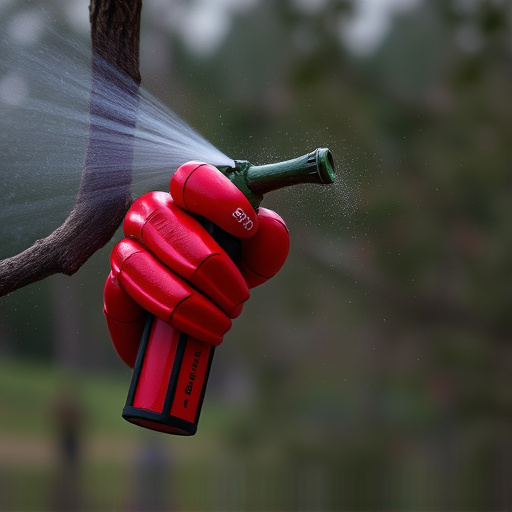Despite potential water dilution, modern pepper spray canisters remain effective in rain due to waterproof formulations and advanced actuation mechanisms. Close range application and specialized equipment enhance performance during wet conditions, crucial for law enforcement managing civil unrest. Training ensures informed decision-making about usage in adverse weather, balancing effectiveness and safety.
“Uncovering the true potential of riot control tools: Exploring Pepper Spray Canisters in Wet Conditions. This comprehensive guide delves into the often-overlooked aspect of pepper spray effectiveness in rainy scenarios. We dissect the science behind these canisters, their performance against moisture, and real-world applications. From understanding the active ingredients to safety precautions, this article offers insights that challenge conventional beliefs about pepper spray’s prowess in wet environments, shedding light on its true capabilities.”
- Understanding Pepper Spray Canisters
- The Impact of Rain on Spray Effectiveness
- Scientific Analysis of Pepper Spray's Efficacy
- Real-World Applications and Safety Precautions
Understanding Pepper Spray Canisters
Pepper spray canisters, a staple in riot control and self-defense, have evolved to become more versatile and effective tools. These devices emit a powerful inflammatory agent, typically oleoresin capsicum (OC), which disrupts the body’s nerve signals, causing temporary blindness, difficulty breathing, and intense pain. The effectiveness of pepper spray is determined by its concentration, delivery mechanism, and weather conditions.
When it comes to pepper spray effectiveness in rain, it’s essential to consider that water can dilute the spray’s potency. However, modern canisters feature advanced design elements, such as waterproof formulations and improved actuation mechanisms, ensuring their performance even in wet environments. These innovations make pepper spray a reliable option for law enforcement and individuals seeking protection in adverse weather conditions, including rain.
The Impact of Rain on Spray Effectiveness
Rain can significantly impact the effectiveness of riot control inflammatory spray canisters, particularly pepper spray. When used in wet conditions, the active ingredients in pepper spray may not disperse as intended, leading to reduced visibility and potential impairment of the target’s respiratory system. The water droplets in the air can also dilute the concentration of the spray, making it less potent.
In terms of pepper spray effectiveness in rain, users need to consider that wet conditions can change the way the spray interacts with the human body and environment. This is especially true for outdoor deployments where rain is common. Adjustments in application technique and awareness of the weather may be necessary to ensure the spray maintains its intended impact, despite the precipitation.
Scientific Analysis of Pepper Spray's Efficacy
Pepper spray, a common riot control agent, has been subject to extensive scientific analysis regarding its effectiveness. One particular area of interest is its performance in wet conditions, especially during rain. While pepper spray’s primary mechanism involves irritating the eyes and respiratory system through capsaicin, its efficacy in raining environments poses unique challenges. Studies have shown that water can significantly dilute the concentration of pepper spray, reducing its impact on targets. However, the chemical’s hydrophobic nature allows it to remain effective even in moist conditions, as it tends to cling to surfaces and individuals.
In terms of Pepper Spray Effectiveness in Rain, research indicates that proper application techniques are crucial. Ensuring a close range between the canister and target increases the likelihood of successful deployment despite moisture. Additionally, using specialized equipment designed for wet weather can enhance pepper spray’s performance by minimizing dilution and ensuring optimal delivery. These findings underscore the importance of training and tactical considerations when employing pepper spray in diverse environments, including those with rainfall.
Real-World Applications and Safety Precautions
In real-world scenarios, riot control inflammatory spray canisters have proven to be invaluable tools for law enforcement and security personnel. These devices are designed to disrupt and disperse crowds, providing a safe distance between authorities and individuals during civil unrest or high-tension situations. The primary active ingredient in these sprays, often capsaicin, is known for its pepper spray effectiveness, causing temporary but intense irritation to the eyes, respiratory system, and skin. This disruption allows for better crowd control and can prevent escalation.
Safety precautions are paramount when using such equipment, especially in adverse weather conditions like rain. While pepper spray remains effective against wet or rained-upon targets, it’s crucial to consider environmental factors. Rain may reduce visibility and impact the range of the spray, necessitating closer proximity for optimal effect. Proper training ensures users understand these nuances, enabling them to make quick decisions that balance effectiveness with safety during dynamic events.
Pepper spray canisters, a key tool in riot control, have their effectiveness influenced by environmental factors like rain. Our analysis reveals that while moisture can reduce spray range and intensity, pepper spray remains a powerful deterrent. Understanding the impact of weather, such as the diminishing effect of rain on Pepper Spray Effectiveness in Rain, is crucial for optimal deployment. By adhering to safety precautions and considering real-world applications, these devices can continue to foster public safety in diverse conditions.
